Winter is here and it is time to think about the warm clothes. What about Russian ‘valenkee’ (ва́ленки)?
In today’s lesson of the “Read and listen in Russian” series we will tell you how Russian felt boots are made. And not only tell, but also show – you will see the entire production process “from A to Z” in pictures.
Sounds interesting? Then let’s get started!
Christmas and New Year Russian vocabulary
Ва́ленками называ́ют во́йлочные сапоги́ из сва́лянной ове́чьей ше́рсти. Проо́бразом ва́ленок бы́ли традицио́нные во́йлочные сапоги́ коче́вников Вели́кой Степи́, исто́рия кото́рых насчи́тывает бо́лее 1 500 ты́сячи лет. Широ́кое распростране́ние ва́ленки приобрели́ лишь в пе́рвой полови́не 19 ве́ка, когда́ их на́чали изготовля́ть промы́шленным спо́собом.
Felt boots are boots made of wool fleece. The orgin of felt boots were the traditional felt boots of the nomads of the Great Steppe, whose history counts more than 1500 thousand years. Felt boots became widespreaded only in the first half of the 19th century, when they began to produce them industrially.
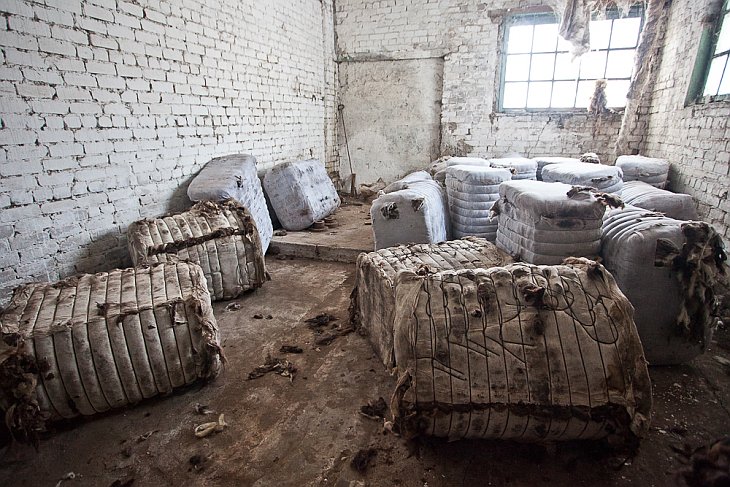
Ва́ляную о́бувь (ва́ленки) в Калязинском райо́не (Тверска́я о́бласть) де́лают уже́ 200 лет. По́сле револю́ции куста́рное произво́дство смени́лось промы́шленным — на ба́зе арте́ли организовалась фа́брика «Кра́сный октя́брь». В 2004 году́ она́ объедини́лась с друго́й, моско́вской фа́брикой «Битца». Так и появи́лось то произво́дство, кото́рое существу́ет на да́нный моме́нт.
Felt footwear (boots) have been made in Kalyazin area (Tver region) for 200 years already. After the Revolution, the hand made production was replaced by industrial production, at the collective cooperative factory “Red October”. In 2004, it was merged with the Moscow factory “Bitsa”. And this is how the production started that exists until now.
Как уже́ бы́ло ска́зано, ва́ленки де́лают из ове́чьей ше́рсти. Пра́вда, яросла́вская рома́новская овца́ для промы́шленного произво́дства не подхо́дит, поэ́тому бе́лую шерсть везу́т из Монго́лии, а се́рую — с Кавка́за и Сре́дней А́зии.
As already mentioned, the boots are made of sheep’s wool. But Yaroslavl Romanov sheeps are not suitable for industrial production, so the white wool is imported from Mongolia, and the gray one – from the Caucasus and Central Asia.
Снача́ла шерсть гото́вят к произво́дству. Она́ прогоня́ется че́рез специа́льный аппара́т, прома́сливается и скла́дывается в большо́м конте́йнере. А да́льше поступа́ет в чеса́льный цех. Здесь всё в па́ру-ды́му, стучи́т, шуми́т и грохо́чет. В чеса́льный агрега́т сза́ди вручну́ю кладётся шерсть, кото́рая расчёсывается колю́чими ва́ликами и нама́тывается спе́реди на специа́льные кату́шки.
First the wool is prepared for production. It is run through a special machine, oiled and gathered in a large container. After that it enters the carding department. Everything here is in steam and smoke, knocks, roars and rumbles. The wool is put manually into the carding machine from behind, where it is combed with prickly rollers and wounded up on the front of a special coil.
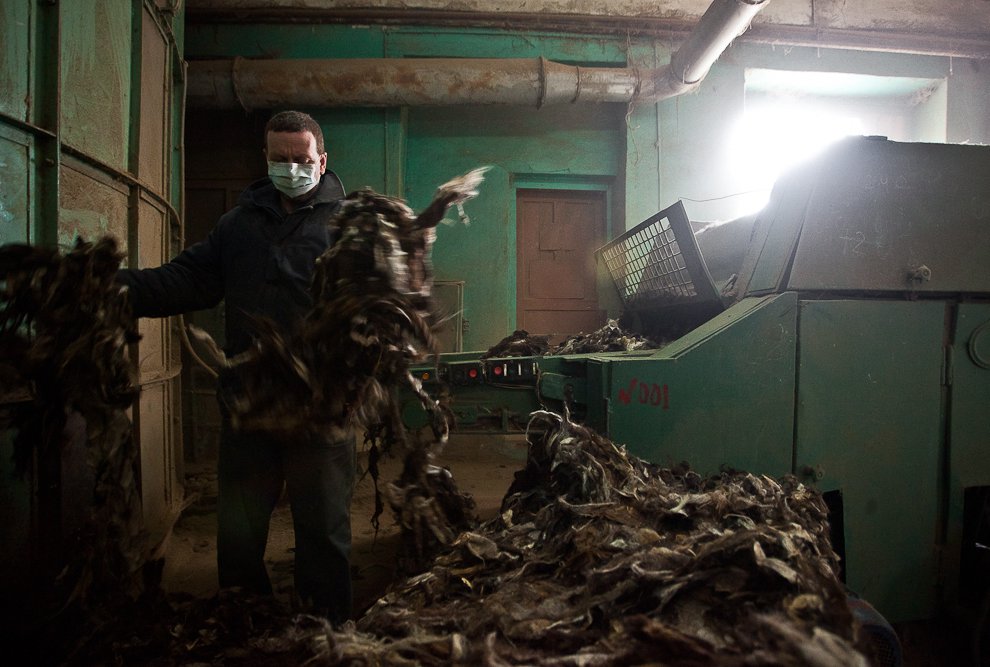
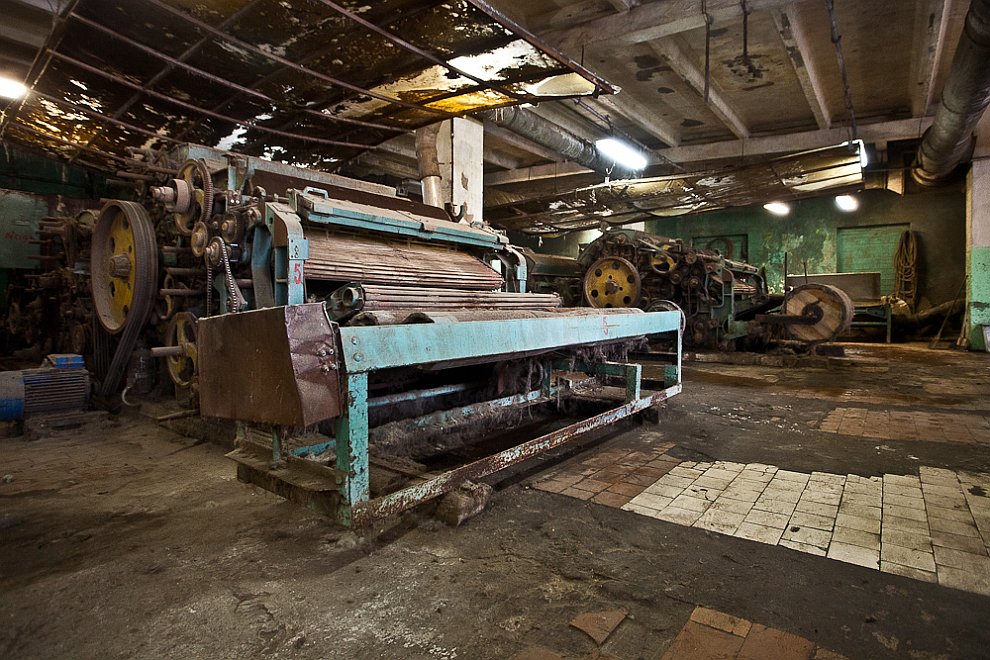
По́сле расчёсывания ше́рсти навива́ется осно́ва бу́дущего ва́ленка, кото́рая прохо́дит прити́рку на э́тих станка́х с па́ром. По́сле прити́рки загото́вки вручну́ю оформля́ется голо́вка ва́ленка — носо́к, пя́тка и подо́шва. Зате́м пуши́стая шерсть опя́ть притира́ется с па́ром.
After combing the wool, the base of the future boot is wounded – it runs on these grinding machines with steam. After the grinding the semimanufacture of the felt boots are made by hand – toe, heel and sole. Then again, the fluffy wool is lapped with steam.
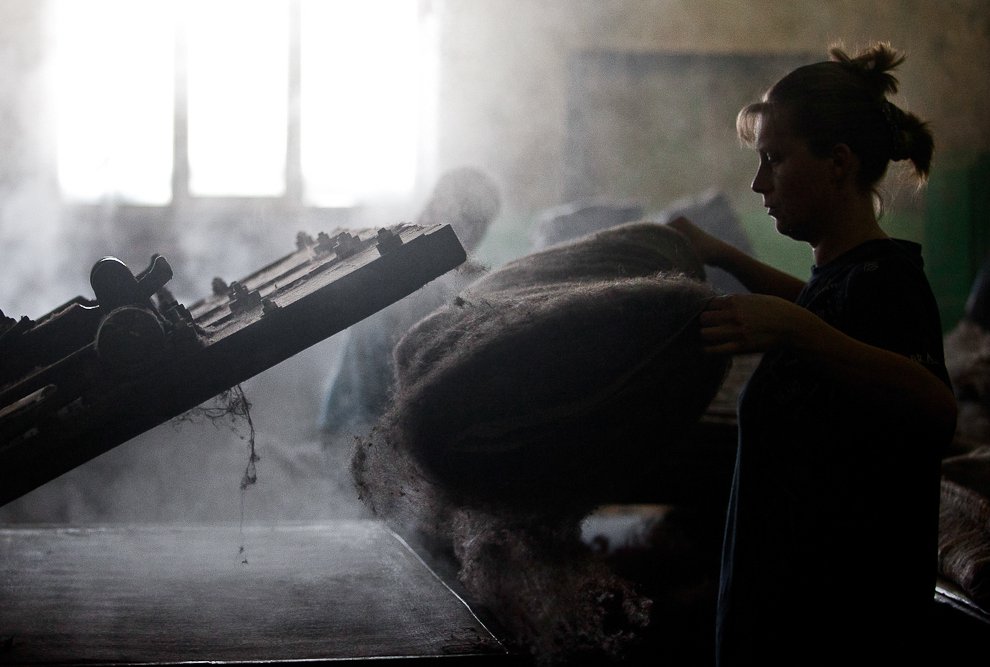
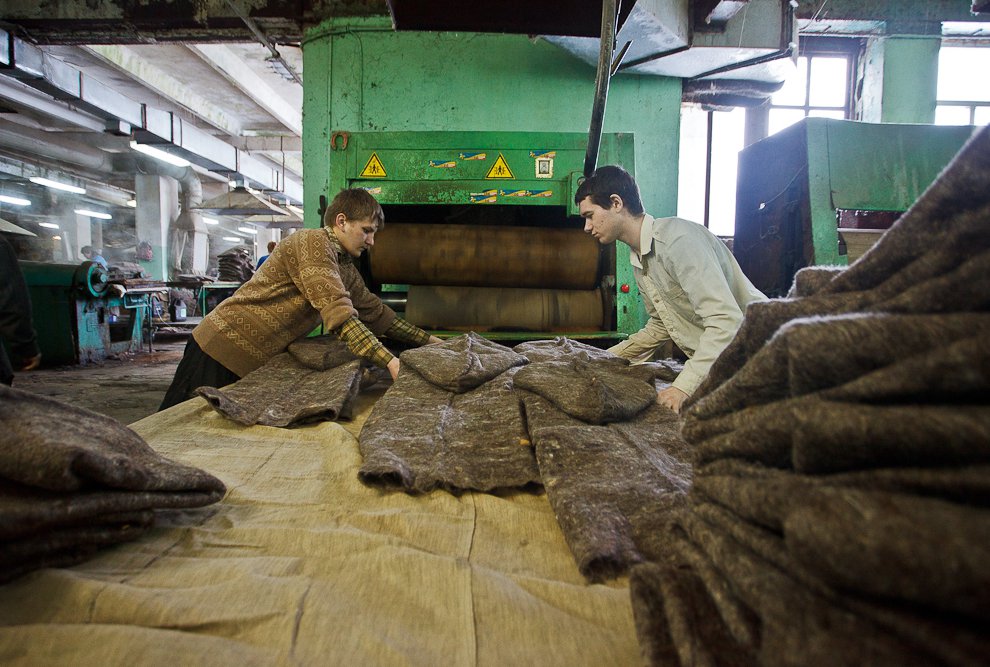
Тепе́рь загото́вки ну́жно собра́ть в па́ртии и отпра́вить в ката́льную маши́ну. Ката́ние, сжимание, пресс — шерсть стано́вится нераздели́мой. Зате́м фо́рму растя́гивают и придаю́т вид ва́ленка. То́лько она́ пока́ что в 2 ра́за бо́льше того́ разме́ра, кото́рый полу́чится в ито́ге.
Now the semimanufactures need to be collected in a batch and sent to natal machine. Skating, squeezing, pressing – the wool becomes inseparable. Then the mold is stretched and formed into boots. Yet, it is 2 times larger than the size of the end product.
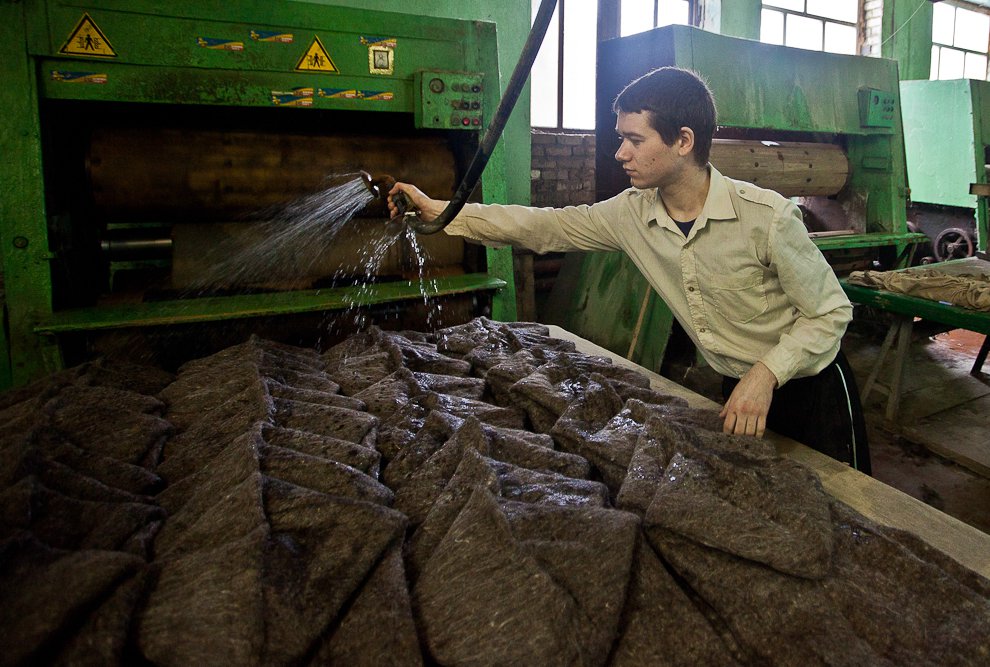
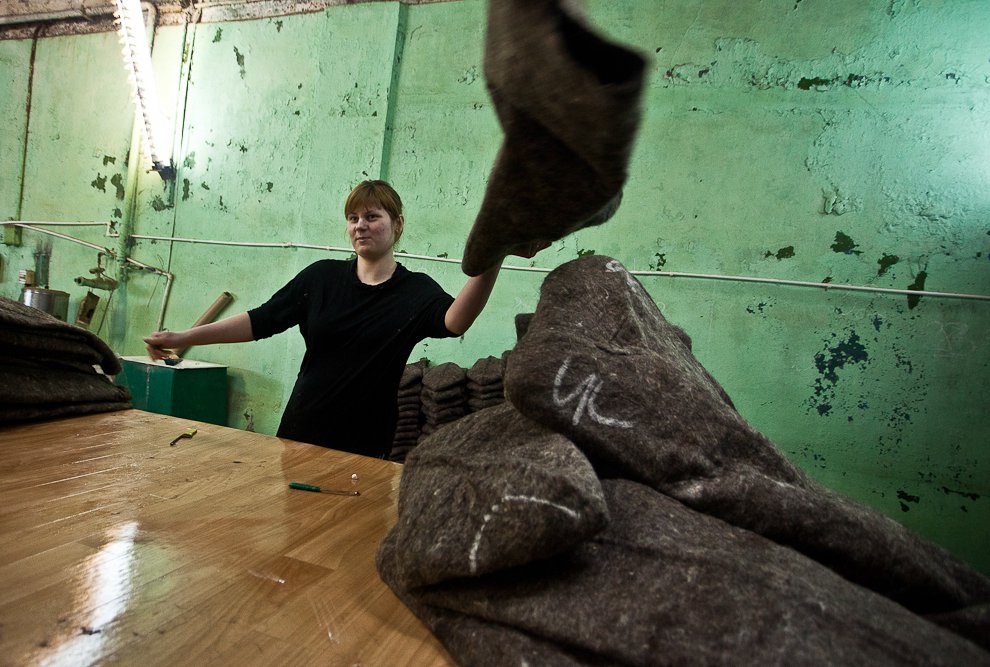
Да́льше — валя́льный цех. Загото́вки кида́ют в напо́лненный водо́й деревя́нный бараба́н, где происхо́дит первонача́льная ва́лка ше́рсти и́ли валя́ние. Вот почему́ ва́ленки называ́ются ва́ленками! По́сле э́того ва́ленки ну́жно поби́ть… деревя́нными башмака́ми валя́льных маши́н. В э́том це́ху то́же всё пари́т и шуми́т.
Next – a fulling workshop. The semimanufactures are thrown into water-filled wooden drum, where the initial roll or felting of wool goes. That is why the boots are called ‘felt boots’! After that the boots need to be beaten … with wooden shoes of fulling machines. In this workshop everything is in steam and makes noise.
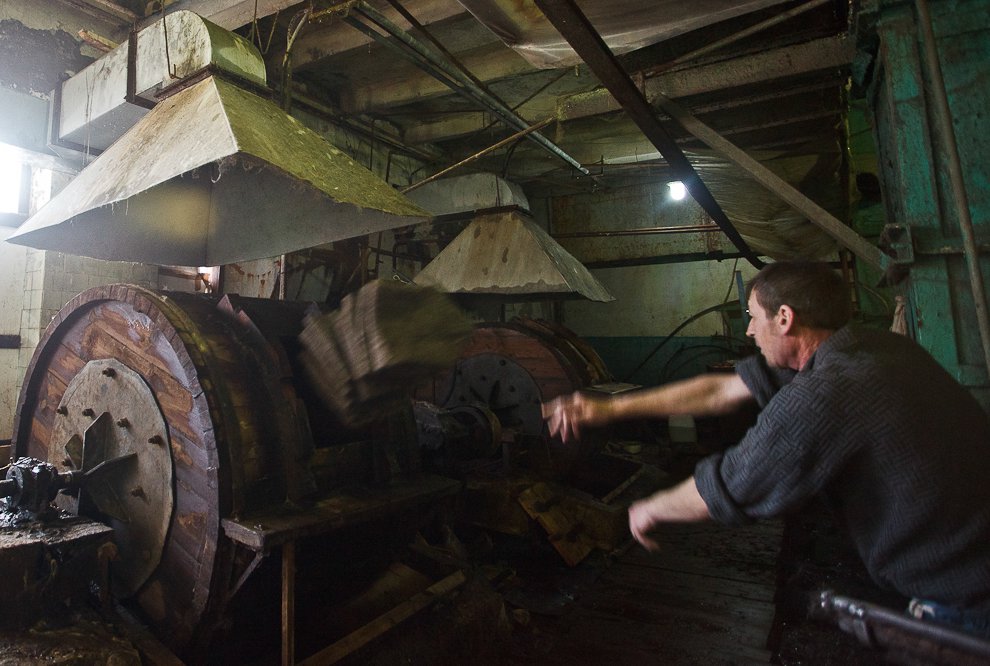
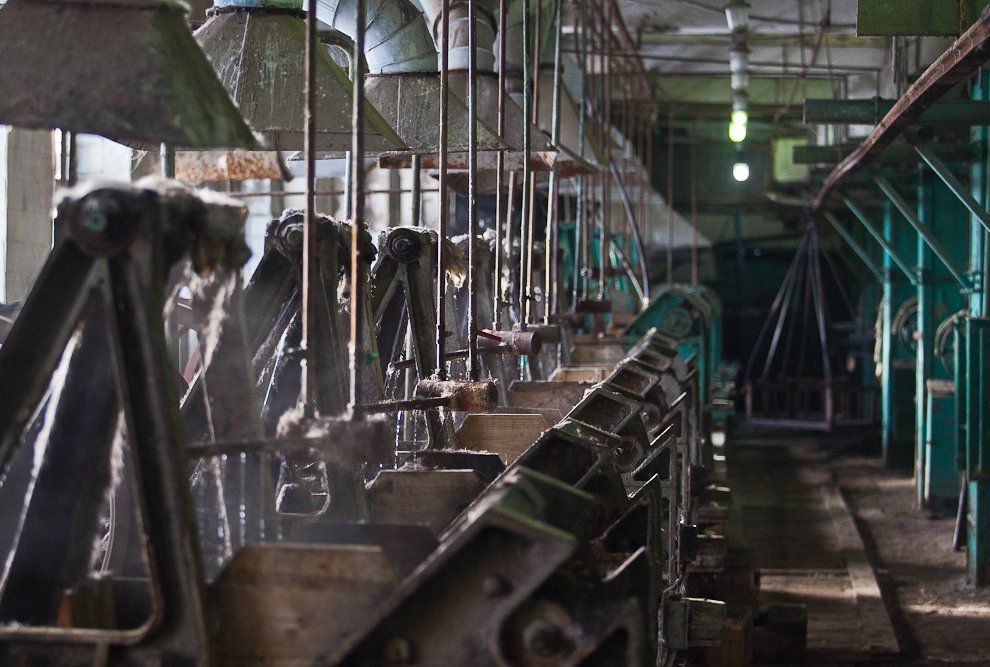
А пото́м загото́вки сно́ва растя́гивают на маши́не, кото́рая на фа́брике называ́ется «крокоди́л». Рабо́тники фа́брики про́сто поража́ют синхро́нностью де́йствий, выполня́я э́ту рабо́ту. Несмотря́ на то, что произво́дство вы́глядит о́чень примити́вно и испо́льзует действи́тельно дре́вние техноло́гии, на рабо́ту здесь никто́ не жа́луется. Есть и молодёжь.
And then the semimanufactures are stretched on a machine that is called “crocodile” in the factory. The factory workers are striking with their synchronized actions doing this job. Despite the fact that the production looks very primitive and really uses ancient technology, no one complains about the work here. There are also young people.
А ва́ленки е́дут да́льше… Тепе́рь их ну́жно смочи́ть, прида́ть фо́рму и разме́р на специа́льных коло́дках. И в печь, суши́ться.
And the boots are going on … Now they need to be moistened, shaped and sized on specific stocks. And to the oven for drying.


Оконча́тельная фо́рма ва́ленкам придаётся путём обстукивания коло́дки. По́сле прида́ния фо́рмы и разме́ра коло́дки бо́льше не ну́жны, их склади́руют до но́вой па́ртии.
The final form of felt boots is given by tapping block. After giving shape and size, the blocks are no longer needed, they are warehoused until the next line is produced.

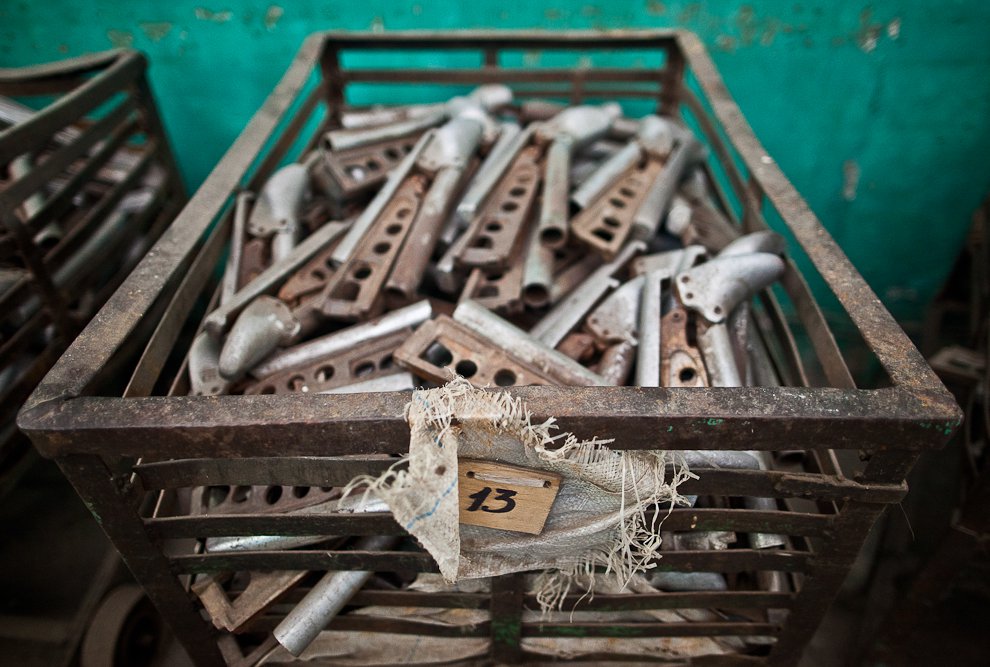
Тепе́рь оста́лось немно́гое. Ну́жно сточи́ть ли́шнюю шерсть, изме́рить получи́вшиеся ва́ленки и подобрать ка́ждому из них па́ру. Не забы́ть прикле́ить фабри́чную би́рку и ме́тку с разме́ром.
Now, all that remains is to grind off the excess hair, to measure the resulting boots and to choose a mate for each of them. Do not forget to glue a factory label and a label with the size.
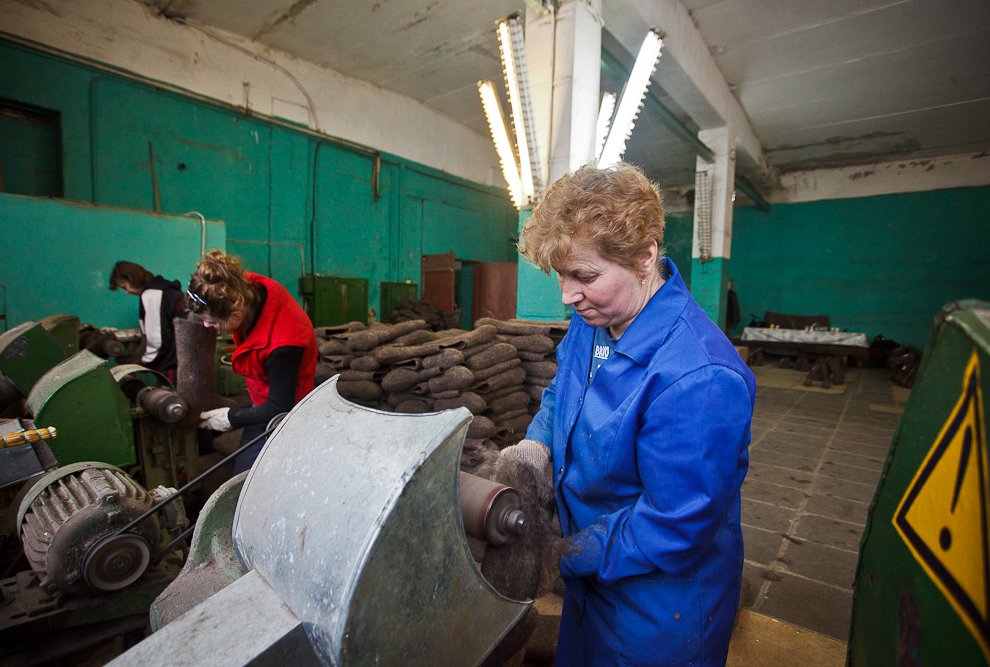
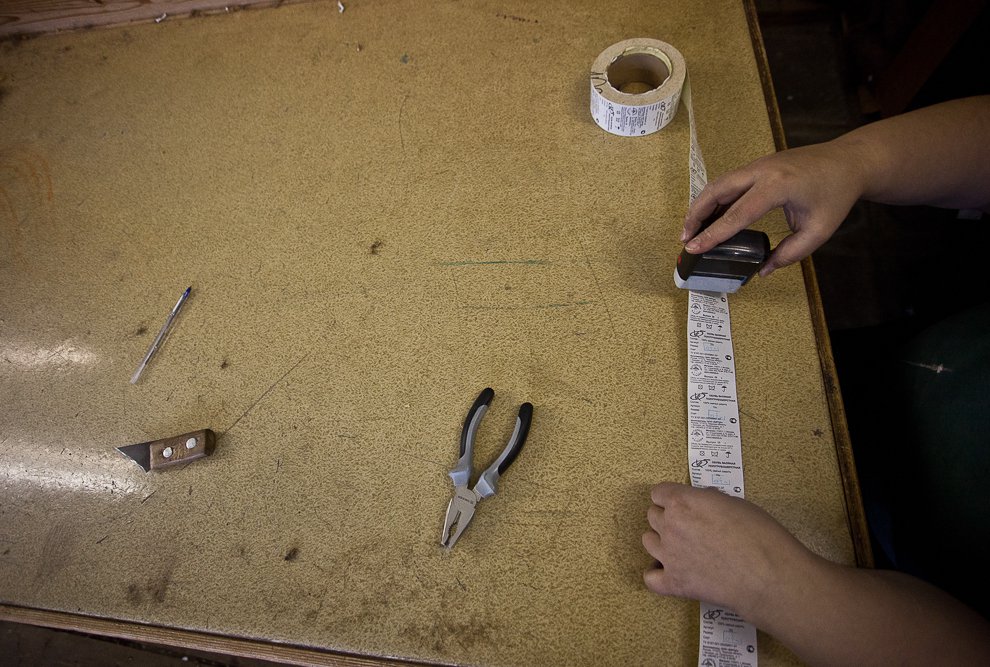
Не́которым ва́ленкам везёт осо́бенно: им дополни́тельно де́лают рези́новую подо́шву в це́ху вулканиза́ции. Вот как э́то происхо́дит: из рези́ны де́лается фо́рма подо́швы, кото́рая накла́дывается на ва́ленок, а зате́м нагрева́ется под пре́ссом и высыха́ет, ли́шнее отреза́ется.
Some felt boots are especially lucky: they additionally get a rubber sole in the shop of vulcanization. Here’s how it works: a sole is made from rubber, then it is superimposed on a boot, and then it gets heated under pressure and dried, the excess is cut off.
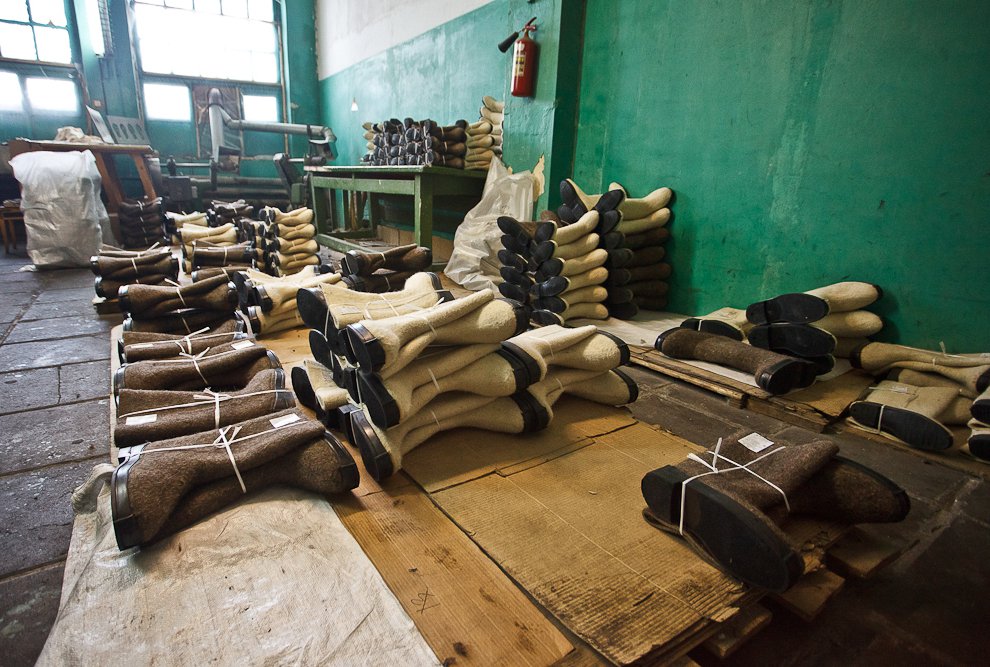
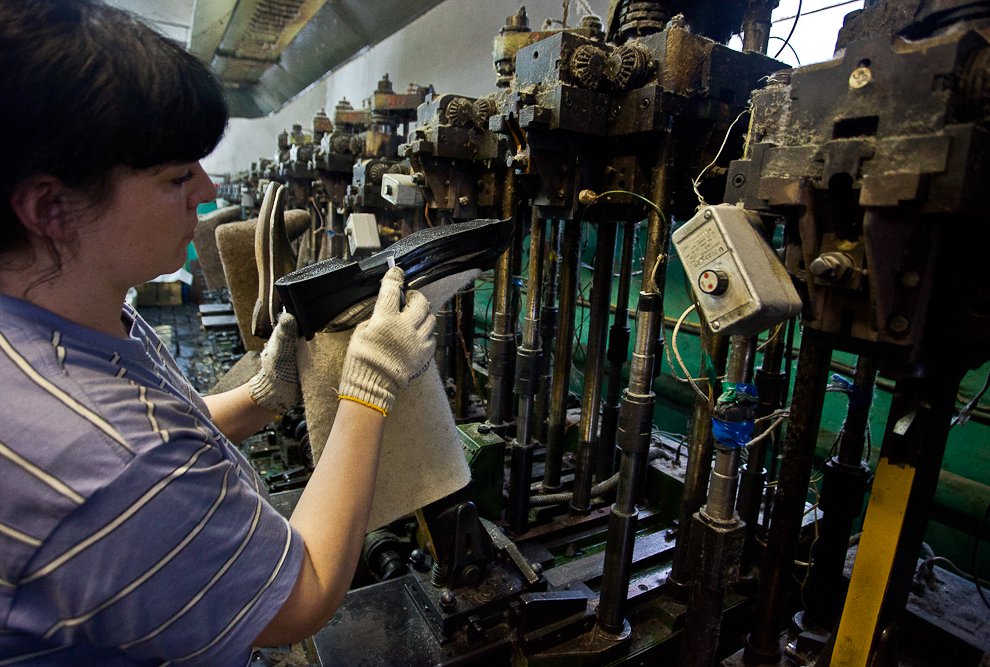
Оста́лось в шве́йном уча́стке приши́ть украше́ния и ва́ленок гото́в. От ше́рсти до э́того эта́па прошло́ о́коло 5 дней. Кста́ти рабо́тницы тут сидя́т в ме́стных ва́ленках. Говоря́т, о́чень удо́бно.
All that remains is to sew jewelry in the sewing room and the boots are ready. From wool to this stage it took them about 5 days. By the way, the workers are sitting here in the local boots. Said to be very comfortable.
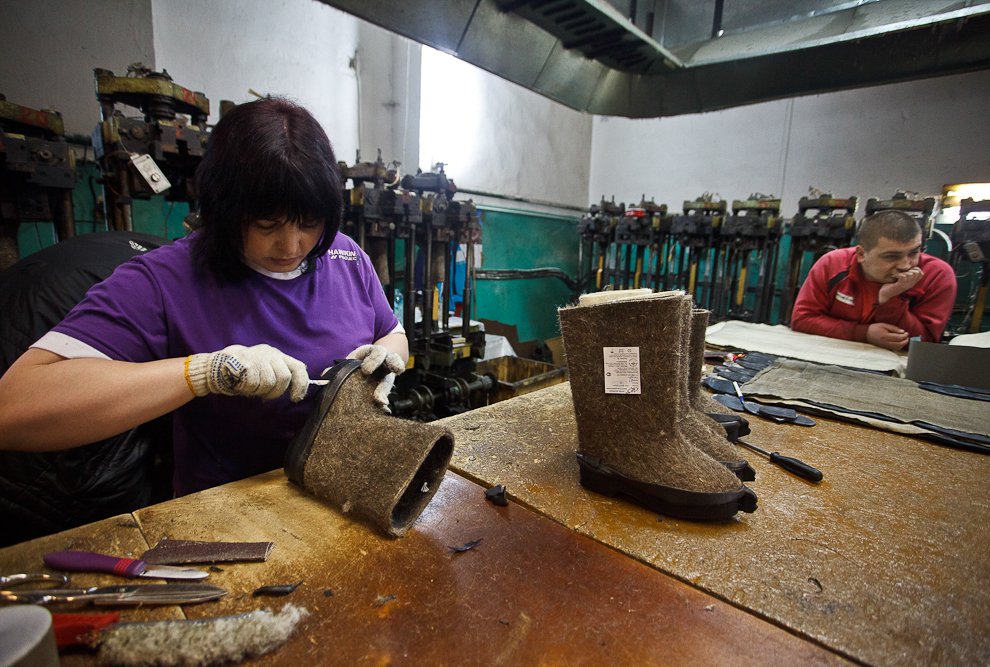
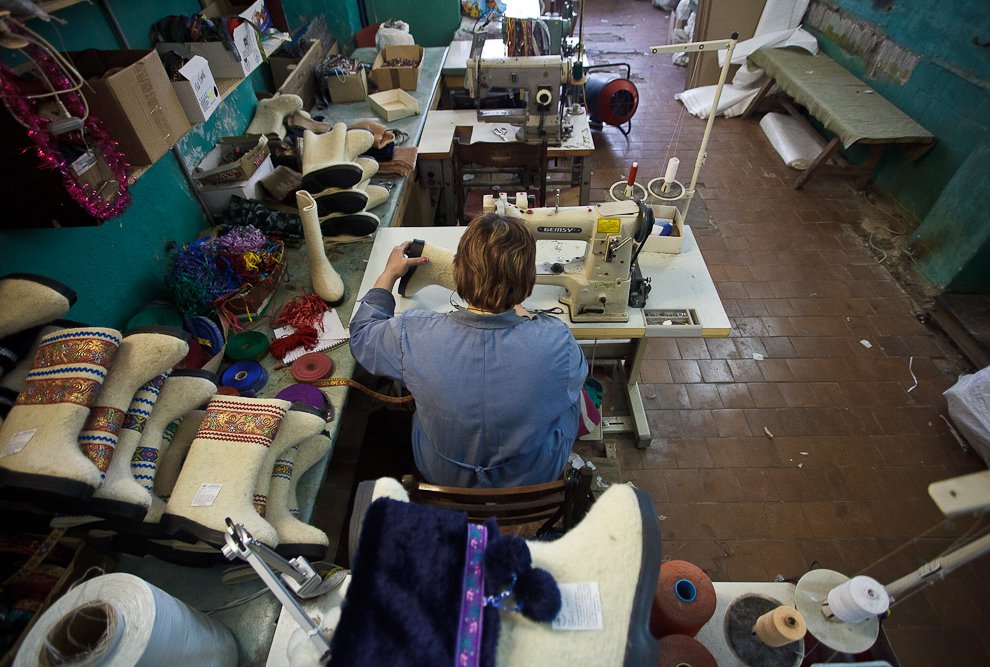
Хоти́те знать, ско́лько зараба́тывают рабо́тники фа́брики? В пе́рвых двух цеха́х зарпла́та составля́ет 24-25 ты́сяч рубле́й в ме́сяц (э́то чуть бо́льше 800 до́лларов и́ли 600 е́вро). У швей зарпла́та поме́ньше — 17 ты́сяч (где́-то 570 до́лларов и́ли чуть бо́лее 430 е́вро).
Do you want to know how much money the factory workers earn? The salary in the first two workshops is 24-25 thousand rubles a month (it is a little more than 800 dollars or 600 euros). The seamstresses earn less – 17,000 (about 570 dollars or a little more than 430 euros).
Source: http://loveopium.ru/texnologiya/kak-delayut-valenki.html


Jeannie says:
Замечательный блог. Очень интересно! Спасибо большое.
Два года тому назад, когда я была на Урале, я посещала скромную фабрику, где тоже делаются валенки. Вот несколько фотографии. (Надеюсь, что адрес отрывается. Это моя страница на Фотострана). http://fotostrana.ru/user/5135105/album/12562923/photos/
Everyday Russian says:
Здравствуйте, Jeannie.
Спасибо за комментарий.
Полагаю, что ссылка открывается только для тех пользователей, что зарегистрированы на Фотостране.
Bing_bing says:
В” Окончательная форму валенкам … ” , “форму” должно ли быть изменено на “форма” ?
【Chinese(simplified)】在“Окончательная форму валенкам …”中, “форму”是否应改为“ форма”?
Everyday Russian says:
Вы правы, Bing_bing.
Спасибо за замечание, мы исправили ошибку.